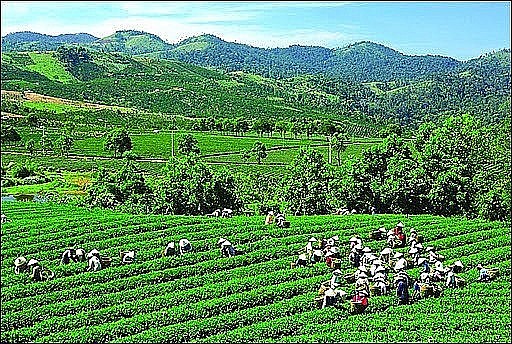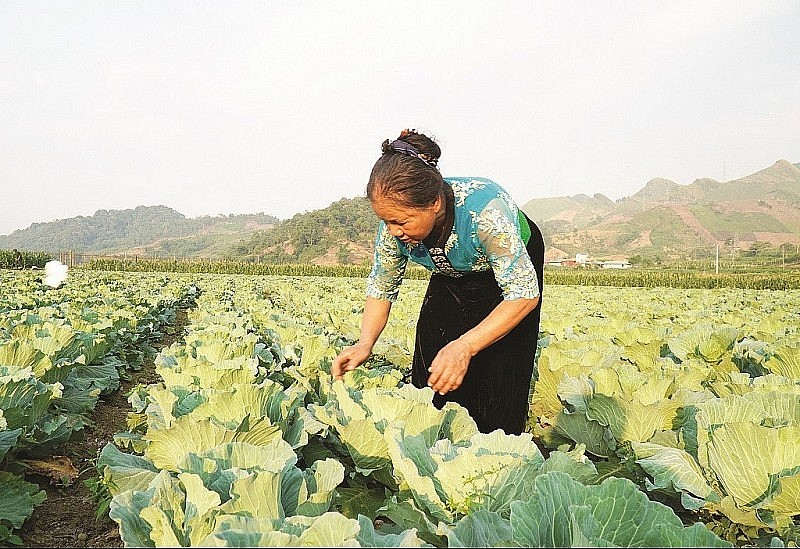
Northern midland and mountainous region: Towards a vision of sustainable development
Latest
 |
| Local authorities in the region promote economic restructuring in association with linkages for development, participation in supply chains and value chains; at the same time, effectively implement the target and key programs. (Source: Lao Dong) |
Missing linkage
The Northern midland and mountainous region consists of 14 provinces directly under the administration of Central Government, and the other 21 western districts of Thanh Hoa and Nghe An provinces. This is considered as an area with diverse and rich natural resources, many unique cultural heritages, and is home to many ethnic minorities. Each ethnic group has its own unique culture, which is expressed through language, costumes, accommodation, cuisine, customs and practices.
Reports from localities show that, after nearly 20 years of implementing Resolution 37-NQ/TW on “Orientation for socio-economic development and assurance of national defense and security in the Northern Midlands and Mountains up to 2020", and the Conclusion 26-KL/TW of the Politburo; with special attention, direction and concentration of investment resources of the Central Government; the initiative and efforts of localities in the region, socio-economic development and defense and security assurance in the Northern midland and mountainous region have achieved many successes; the region's GRDP growth over the years has improved.
In recent period, the quality of growth has gradually shifted from breadth to depth; the economic structure shifts in a positive direction, reducing the proportion of agriculture - forestry - fishery, increasing the proportion of industry and services. The average poverty rate in the region decreased sharply.
Some important highways, such as Hanoi - Lao Cai, Hanoi - Thai Nguyen have been built.
However, according to experts, the linkage within the region and with the Red River Delta and the Capital region is still weak, with low efficiency; the development space is divided according to administrative boundaries, all of which has not fully brought the potential and advantages of the locality in the region into play.
In particular, the system of roads connecting the East and West is still small. The coordination between modes of transport is not reasonable, or synchronous, and the connectivity is not high. The border road system still faces many difficulties. Railway infrastructure is not suitable for international connections.
Besides, there is a lack of regional databases on key products, human resources, specific industries, fields, and advantageous products, leading to ineffectiveness of within-region and inter-regional cooperation. People's lives are still in difficulties, especially in areas with a large number of ethnic minorities.
A need for innovative thinking
On the basis of objective assessment of achieved results and difficulties and limitations in the linkage development over the past, Mr. Nguyen Xuan Thang - Rector of Ho Chi Minh National Academy of Politics - said that localities in the region need innovative thinking, long-term vision and synchronous planning; the leaders must overcome the thinking of just-for the assigned tenure, short term, localized ideology, and/or localism so that there must be a determination to change, new ways to promote the building of truly effective institutional linkage in the region.
Accordingly, in the renewal of regional linkage of institutions, instead of focusing on forming administrative apparatuses, a more flexible coordination mechanism is needed; removing bottlenecks, focusing on breakthroughs in transport infrastructure and digital infrastructure, first of all on inter-regional highways, forming a development corridor, connecting seaports, international airports, and international export gateways.
The localities in the region promote economic restructuring in connection with linkages for development, participation in supply chains and value chains; at the same time, effectively implementing key focal programs.
According to Minister of Planning and Investment Nguyen Chi Dung, the issue of national master planning in general and planning and regional linkage in particular, if it is correctly and successfully performed, will determine the shortest and scientific way of organizing the development space, development orientation, development method in accordance with the context and situation of each period.
 |
| Clean vegetables of Van Ho Safe Vegetable Farming Cooperative, Son La province.(Source: Ethnicity and Development Newspaper) |
In order to develop and implement the regional and provincial planning with quality and vision, there must be cohesion of localities in the region to take advantage of available opportunities and at the same time limit the destruction of resources of each locality.
The question of orientation and organization of development space could go beyond the administrative boundaries of a province and needs to be approached and solved by virtual regional councils, through collective action. Therefore, the 14 northern midland and mountainous provinces need to have a common perception, a common goal from which to actively cooperate and link together under the motto "If you want to go fast and go far, go together”. It is also the trend of linkage, sharing and cooperation of the world economy today.
Enhancing the viewpoint of Minister Nguyen Chi Dung, other experts stressed: “it is necessary to change the perception, thinking and actions of the whole political system to link the regions to become the driving force of growth; focus on linking construction and organizing the implementation of the planning; linkages in investment in socio-economic infrastructure, especially transport; cooperation in training and improving the quality of human resources; linking to form specific economic spaces in terms of agriculture, tourism, border-gate economy, economic corridors, linkage in promotion and attraction of investment.
| The Northern midland and mountainous region is inhabited by many ethnic groups, but there are differences between the Northeast and the Northwest. The Northeast region is inhabited by the Tay, Dao, Muong, Nung...; The Northwest is inhabited by the Thai, Mong, and Dao... Each ethnic group has its own cultural identity, diversity and uniqueness. |





















